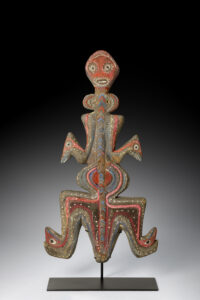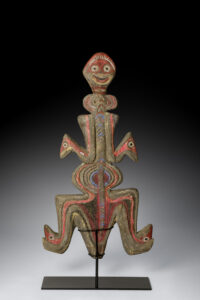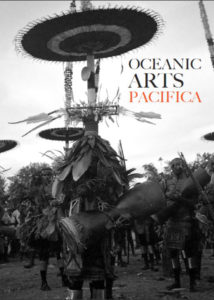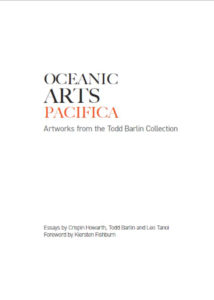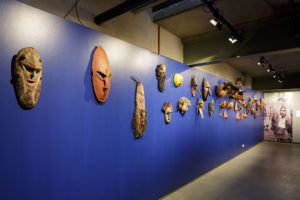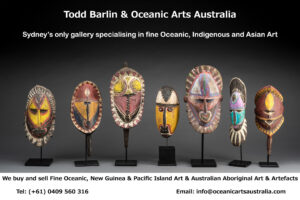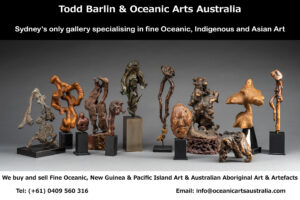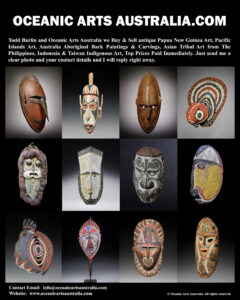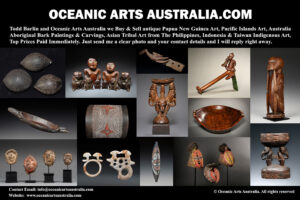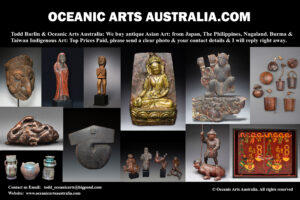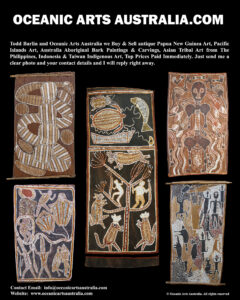A Superb Old New Guinea Basket Hook Figure Kwoma People Waskuk Area Upper Sepik River Papua New Guinea
| Collection No. | TB-1442 |
|---|---|
| Size | Height 95cm x 52cm |
A Superb Old New Guinea Basket Hook Figure from the Kwoma People in the Waskuk Area of the Upper Sepik River East Sepik Province of Papua New Guinea
This rare and beautiful double-sided Basket Hook Figure was made from the intense creativity of a Kwoma artist, depicting either a power Bush or Water Spirit called sikilawos whose legs & arms are transformed into totemic birds. It is beautifully painted with both ochre and trade paint. This is the only Kwoma Sculpture or similar Basket Hook Figure that I have ever seen.
Basket Hooks were used for protecting food or other objects from rodents, the hook would hang from the ceiling by a rope, and string bags were hung from the hook with food or other important objects that then could not be reached by rats or mice, a simple effective technology used by cultures around the world.
Sepik River artists made many beautiful unitarian art objects like Basket Hooks that were both functional and a way of honoring and making visible their ancestors and spirits in daily life.
Birds in New Guinea art can be important clan totems and also anthropomorphic spirit beings that are the primordial bird-men and bird-women, who created the sacred musical instruments, consisting of bamboo flutes and slit gongs that were kept within the ceremonial houses and played a central role in the ritual life of their communities.
This very beautiful old Kwoma sculpture has been one of my favourite Oceanic Artworks that I have ever owned, it has a soft gentle surreal feel where often Middle Sepik artworks can seem aggressive, Waskuk/ Kwoma Art in my opinion is one of the great art styles of Papua New Guinea.
Provenance: The Todd Barlin Collection of Oceanic Art
Exhibited Oceanic Arts Pacifica: Oceanic Art from the Todd Barlin Collection at Casula Powerhouse Arts Centre 2014
The Kwoma people and their closely related neighbors the Nukuma and Manambu share a unique tradition revolving around the cultivation of yams. An annual series of rituals associated with the yam harvest ensures the tuber’s continuing abundance and renders it suitable for human consumption. Clans sponsor the events, which are staged in a sequence of three rituals each involving different types of figures.
For the annual ceremonies, both old and new sculptures are freshly painted, as their power lies in the bright polychrome ochre paint applied to their surfaces, for the Kwoma people the paint is a magical substance that endows the figures with supernatural power and beauty.
Provenance: The Todd Barlin Collection of New Guinea Oceanic Art
See my new EXHIBITIONS GALLERY showing the Museums and Art Galleries Exhibitions that I provided artworks for over the past 40 years. There is the link to the article about my artworks published in the prestigious Louvre Magazine in 1996
I have artwork for Museums and art Galleries but also for collectors at every stage of their collecting. I want to encourage people to explore the fine art of New Guinea & West Papua and the Pacific Islands and to be able to see and touch the artworks in a relaxed and friendly manner in my Sydney Gallery. I would like to invite you to visit my gallery and see the artworks in person and also look at my website www.oceanicartsaustralia.com where there are many Galleries & Sub Galleries to explore.
My Gallery of nearly 40 years is the last physical gallery in Sydney that specializes in New Guinea and Oceanic Art. Sydney is very close to New Guinea & the Pacific Islands where all of these amazing artworks came from, Australia’s closest neighbors.
To see many more rare items and the finest masterpieces, please make an appointment with us to visit the gallery.
For all inquiries, please contact us

